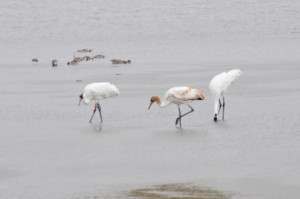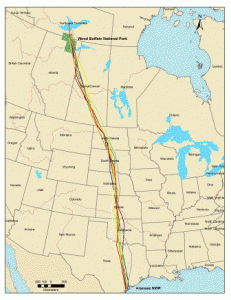As the previous newsletter detailed, in August 2010 researchers captured nine whooping crane chicks at Wood Buffalo National Park. This ongoing project intends to answer questions regarding whooping crane migratory ecology and behavior during migration using GPS. The project uses solar Argos Global Positioning System (GPS) Platform Transmitter Terminals (PTTs) attached to tarsal bands. Birds are also marked with color leg bands similar to those used from 1977-1988. At least eight of the chicks thus banded fledged, and successfully migrated to Aransas NWR. After spending the winter months in Texas, the family groups began heading north in late March, with most of them having reached WBNP by the first week of May.

Whooping crane family with banded individual. Photo by Cathie Foster
Researchers also conducted capture efforts at Aransas NWR this past January. Crane Capture Guru David Brandt (Northern Prairie Wildlife Research Center) was ably assisted by Felipe Chavez-Ramirez (Gulf Coast Bird Observatory), Barry Hartup (International Crane Foundation), Edgar Lopez-Saut (CIBNOR La Paz), Claudia Doria-Treviño (UNANL) and Walter Wehtje (The Crane Trust). Using corn, fishing line and a fishing pole, we were able to capture an adult female whooping crane at the ANWR’s Lamar Unit on 8 January 2011. Given that this bird‘s territory included Lamar’s 8th Street, it quickly became the most viewed and photographed banded Whooping Crane in south Texas (pictured left). Adding the chicks banded at Wood Buffalo NP and the two birds banded in December 2009 at Aransas, we are now following 11 members of the Aransas Wood Buffalo Population of whooping cranes.
Under ideal conditions, the PTTs provide four GPS locations per day. These data are stored by the device and every 56 hours uploaded via satellite to Argos. From here, we download the data and analyze it using ArcGIS. This allows us to follow their migration in near real-time. With each PTT expected to provide data for at least three years, we are looking to learn much about the lives of these birds. The preliminary analysis has provided a wealth of detail and greatly increased our understanding of their migratory habits.

Spring migration routes taken by whooping cranes with gps transmitters. Figure courtesy The Crane Trust, Inc.
One of the most gratifying findings was that all of the juveniles survived their first migration experience. Except for one PTT that only functioned intermittently, we were able to follow each bird’s movements from Wood Buffalo down to Aransas (Pictured right). While the time spent in migration by the families varied from 14 to 48 days, the number of days during which they actually covered more than 30 km (18 mi) in flight ranged from 9 to 12. The balance of their time was spent at staging grounds in Saskatchewan, North Dakota and South Dakota. The maximum distance covered by one family in a day was 965 km (600 mi) at the end of which they spent the night in a recently harvested corn field; they must have been tired (cranes normally spend the night roosting in shallow water). The sub-adult that was banded in 2009 traveled with Sandhill Cranes throughout much of the fall. Once he reached Aransas he quickly moved to the salt marshes and associated with other whoopers for the whole winter.
The first banded family group departed Aransas on 21 March and the last left on 6 April. As of this writing most of the birds have arrived at Wood Buffalo NP and the adult female banded this past January is moving very little, suggesting she may already be incubating. Equally interesting has been the behavior of the yearling birds. One of them flew up to Wood Buffalo, but then flew back south and has now been in central Saskatchewan for the past week, where it appears that two other yearlings have also ended up. It looks as if every season will continue to bring new insights and surprises.
Walter Wehtje, The Crane Trust, Inc.

